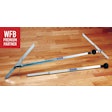For the contractor, the beauty of prefinished hardwood flooring is in the simplicity of installation, with fewer steps on the job site. The hardship of prefinished hardwood is that it will eventually wear, and refinishing it can seem like an overwhelming challenge.
Manufacturers of prefinished flooring continue to make aluminum-oxide finishes harder and harder in order to increase the floor's life. As a result, sanding an aluminum-oxide prefinished floor down the road is one of the hottest issues in our industry today. At a recent trade show, I overheard several prefinished manufacturers boasting there wasn't a machine or product on the market that could sand off their finishes.
It is a puzzle that has contractors and distributors scratching their heads. Some contractors have lost money on jobs when they didn't realize before the job started that the floor was aluminum oxide. Others lose money by choosing to not take on jobs resanding aluminum-oxide-coated wood floors.
Just as finish technology has advanced significantly over the past 10 years, so too has abrasive technology. It's critical for contractors and distributors to keep up. As with any puzzle, the more information you have, the easier it is to solve. You want to work smarter, not harder.
Finish Facts
First, you must understand the finish. It does have aluminum oxide in it; however, that additive alone is not what makes it so hard; it is the UV-curing process used in the mills that really creates the hardness.
When finish is applied to prefinished flooring during the manufacturing process, it is done in the most controlled setting possible—as opposed to the conditions on a job site. The contractor can never fully create the ideal curing conditions found in a mill, so there is a large difference in hardness.
Know Your Abrasives
First, be aware that aluminum oxide in powder form is very dangerous to breathe, so it is essential that crews use proper respirators when sanding an aluminum-oxide floor.
When trying to sand that finish, you need to select the right abrasive grain type and grit size. Know what is in the abrasives, because not all abrasives are made the same.
There are four types of abrasive grains commonly used in the wood flooring industry. Only two of them are useful in sanding aluminum-oxide finishes: silicon carbide and ceramic grain.
With silicon carbide abrasives, the grain macro-fractures, meaning that before the grain can dull, it breaks into smaller pieces that essentially resharpen the abrasive.
So, silicon carbide abrasives stay sharp until they die, but they die relatively quickly. That makes silicon carbide the least expensive option per belt price, but product life is shorter.
RELATED: The Basics of Sanding Wood Flooring
With ceramic grain abrasives, the grain micro-fractures, meaning that it breaks down in much smaller razor-like pieces more times before the abrasive dulls. Although the cost per ceramic belt is in the neighborhood of 50 percent higher than that of most silicon carbide, it usually provides two to four times the performance. Performance level depends on the ratio of ceramic grain used, so be sure to ask your distributor or manufacturer what is in each product: 100 percent and 15 percent ceramic grain are not equal.
When choosing the abrasive, it is important to separate price and cost. The "price" per belt will be higher on the ceramic, but the "cost" of the total job (product consumed and time/labor) will be significantly lower.
Choose the Right Grit
The final piece of the puzzle is grit selection. A common misconception when dealing with aluminum-oxide floors is to start with the roughest grit you can find. Believe it or not, just because an abrasive feels more aggressive does not mean it is.
When trying to abrade very hard materials, the opposite approach is needed. Think of it this way: take a big block of ice and try to smash it with a large mallet. What happens? More often than not, the mallet bounces off and the ice remains relatively unaltered. Now take that same block of ice and chisel at it with an ice pick. The pick penetrates the ice, no problem.
When sanding aluminum-oxide finishes, the same concept applies. Rather than start with the most aggressive grit you can find (the large mallet), start with something finer, like an 80 grit (the ice pick). The finer belt will break up the finish, and after that, you can move to the rougher grit to get the floor flat and take it from there.
Mystery solved. Knowing these facts will help make sweating over resanding prefinished flooring a thing of the past. Good luck.
































